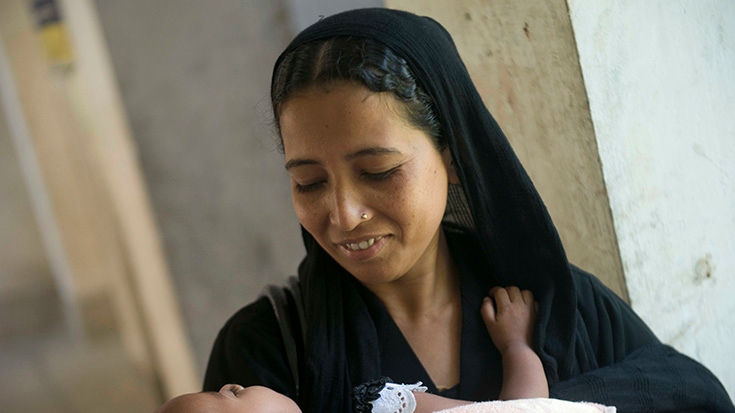world bank, dhaka branch, jan 2015
The ‘science of delivery’, or bringing the right kinds of services effectively to the poor, is the key to eradicate extreme poverty, said Sir Fazle Hasan Abed, the founder and chairman of BRAC, the world’s largest NGO.

The under-five child mortality in Bangladesh has decreased from 180 deaths per 1,000 live births in the 1980s to 53 deaths per 1,000 live births in 2011. The child survival rate in Bangladesh has surpassed that in neighboring countries.
smail Ferdous/World Bank
While visiting the World Bank Bangladesh office, he shared how perfecting the science of delivery helps reduce poverty; saves lives; brings prosperity; and how one impact is linked with another.
In 1972 BRAC started working on integrated rural development in Bangladesh. The country had an alarmingly low child survival rate at the time. Diarrhea was among the leading causes of the death of children. BRAC took the lead in popularizing the Oral Rehydration Therapy (ORT) to prevent diarrhea. Bangladesh now has the world’s highest ORT usage rate. Thanks to ORT and the later success in child immunization, the under-five child mortality in Bangladesh has decreased from 180 deaths per 1,000 live births in the 1980s to 53 deaths per 1,000 live births in 2011. The child survival rate in Bangladesh has surpassed that in neighboring countries.
A mother needs boiled water, sugar and salt from her kitchen to prepare ORT. A simple solution, but the challenge was to reach the millions of mothers, teach them how to prepare the saline solution and ensure the proper feeding of sick children.
BRAC employed female health workers from the community to go door to door and teach mothers to prepare and administer ORT. The rural and often illiterate mother would need to remember 7 simple points of ORT. The health workers used to mark their utensils to measure half a liter of water, adding a pinch of salt with the fingertips and a fistful of molasses, a substitute to sugar in villages.
“BRACs methodology always focuses on strong monitoring mechanism to measure the progress of any intervention and maintain quality and accountability,” says Sir Abed. BRAC representatives would randomly monitor 10 percent of households. Each health worker received 10 Takas ($.12) per household if the mother could remember the 7 points of ORT accurately.
Unfortunately, the first round of monitoring showed a disappointing 6 percent household usage rate. BRAC realized that the health workers themselves did not believe in the intervention. BRAC trained the health workers to show how ORT works. The new found belief in the intervention increased the usage rate to 19%, but still far below making a meaningful impact nationally.
Further analysis showed that men felt undermined by not being adequately engaged. BRAC workers started to engage the fathers. To cut time and cost by half, workers started teaching mothers in groups instead of an one on one basis and monitoring the monitors. Meetings were organized in markets, schools and mosques to explain the benefits of ORT. National TV and radio launched a campaign to popularize ORT. Once the whole village was mobilized, the results were remarkable.
Sir Abed said, “It involved several incremental steps to deliver the desirable service to the poor. First, making the program effective; second, refining the intervention based on the trial and error to make it efficient; and third, a focus on robust monitoring and accountability mechanism allowing the scaling up of the intervention nationwide.”
Citing examples of interlinked development impacts, Sir Abed highlighted that the fertility rate among Bangladeshi women declined during the same period. Bangladesh today has almost achieved a replacement level fertility rate of 2.2 children per women.
The experience shows that through efficient delivery, simple local solutions can bring positive changes in the lives of millions. And to do so, we need to identify effective and available avenues of delivery, easy ways of scaling up the initiative, learn from the failures and rectify. We learn, at each stage, vigilant monitoring, impact assessment, and quick redesigns to improve the intervention.
The delivery mechanism in ORT initiative reconciles with many projects within the Bank to reach out to the poorest of the society. This experience can be applied to bring services to millions of people worldwide for poverty reduction and human development.
“Bangladesh has shown remarkable progress through simple solutions as ORT. These efforts could be replicated as a model in any development project world-wide,” remarked Sir Abed ending his knowledge sharing with staff in the Dhaka office.



